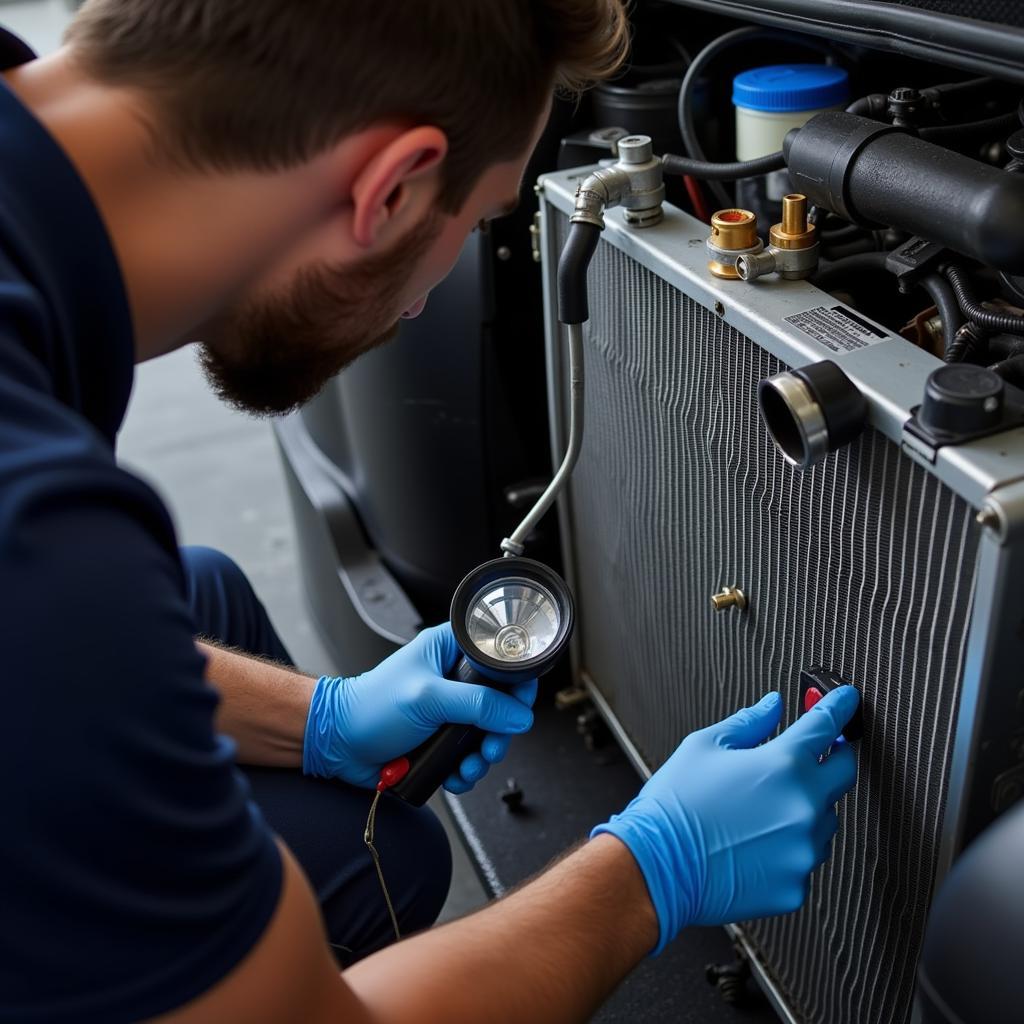A leaking car radiator can lead to overheating and serious engine damage. Understanding how to diagnose and repair a car radiator leak is essential for any car owner. This guide will provide you with a comprehensive walkthrough of the process, from identifying the leak to implementing effective solutions.
Identifying a Car Radiator Leak
Locating the source of your radiator leak is the first step. Look for these common signs:
- Low coolant levels: Frequently needing to top up your coolant is a telltale sign.
- Overheating engine: A leaking radiator compromises the cooling system, leading to overheating.
- Visible coolant leaks: Check for puddles under your car or dampness around the radiator itself.
- Sweet smell: Coolant has a sweet odor that can be detected inside or outside the car.
- White smoke from the exhaust: This can indicate coolant is leaking into the engine.
Pinpointing the Leak
Once you suspect a leak, it’s time to pinpoint the exact location.
- Visual inspection: Carefully examine the radiator, hoses, and connections for any visible cracks, holes, or signs of corrosion.
- Pressure test: A pressure test can help identify leaks that aren’t readily visible. This involves pressurizing the cooling system to reveal weak points.
- Dye test: A dye test involves adding a fluorescent dye to the coolant. This dye will highlight the leak under UV light, making it easier to spot.
 Inspecting a Car Radiator for Leaks
Inspecting a Car Radiator for Leaks
DIY Radiator Leak Repair Options
Depending on the severity and location of the leak, several DIY repair options are available.
Radiator Stop Leak
Radiator stop leak products are readily available and can be a temporary fix for small leaks. These products seal the leak from the inside by reacting with the coolant. However, these are not a permanent solution and should be used with caution.
Hose Repair or Replacement
If the leak is in a hose, repairing it with hose repair tape or replacing the entire hose is a relatively straightforward process. Ensure the engine is cool before working on any hoses.
Radiator Patch
For small cracks in the radiator itself, a radiator patch can provide a temporary seal. Clean the area thoroughly before applying the patch.
 Applying a Radiator Patch to a Small Leak
Applying a Radiator Patch to a Small Leak
When to Consult a Professional
While some radiator leaks can be addressed with DIY methods, more complex issues require professional attention. If you’re unsure about the cause or severity of the leak, or if you’re uncomfortable working on your car’s cooling system, it’s best to consult a qualified mechanic.
“Ignoring a small radiator leak can lead to significant engine damage down the line,” says John Miller, Certified Automotive Technician at Miller’s Auto Repair. “It’s always better to address the issue promptly to prevent further complications.”
Preventing Future Radiator Leaks
Regular maintenance is key to preventing future radiator leaks.
- Regular coolant flushes: Flush your coolant according to your car’s manufacturer recommendations.
- Inspect hoses and connections: Regularly inspect hoses for cracks or wear and tear.
- Check coolant levels: Keep an eye on your coolant levels and top them up as needed.
- Use the correct coolant type: Using the wrong type of coolant can damage the radiator and its components.
Conclusion
Knowing how to repair a car radiator leak can save you time and money. By following this guide, you can identify and address minor leaks yourself. However, for more complex issues, always consult a professional mechanic. Regular maintenance and preventative measures can help keep your cooling system in top shape and avoid costly repairs down the road.
FAQs
- What causes a car radiator to leak? Common causes include corrosion, wear and tear, physical damage, and faulty components.
- How much does it cost to repair a radiator leak? The cost varies depending on the severity and location of the leak.
- Can I drive with a leaking radiator? Driving with a leaking radiator can cause severe engine damage. It’s best to avoid driving until the leak is repaired.
- How often should I flush my coolant? Consult your car’s owner’s manual for specific recommendations.
- What type of coolant should I use? Refer to your owner’s manual for the correct coolant type for your car.
- What are the signs of a leaking radiator? Signs include low coolant levels, overheating, visible leaks, a sweet smell, and white smoke from the exhaust.
- How can I prevent radiator leaks? Regular maintenance, such as coolant flushes and hose inspections, can help prevent leaks.
“Preventive maintenance is the best way to avoid costly radiator repairs,” adds Maria Sanchez, Lead Mechanic at Sanchez Automotive. “Regular checks can identify potential problems early on.”
For further support, contact us via WhatsApp: +1(641)206-8880 or Email: [email protected]. Our customer service team is available 24/7.

Leave a Reply